This post contains affiliate links. When you buy through our links, we may earn a commission.

Even if it is very comfortable and practical to wash the dishes in the dishwasher, all the kitchen utensils do not necessarily support the humidity. These include the detergent products and the heat inside the dishwasher when in use.usten
This is because you could then have a few surprises when you open the dishwasher door!
Rest assured, stainless steel, as a general rule, is known to be resistant and has an undisputed lifespan over time. But then, what are the exceptions?
Read the article if you want to learn about the good practices when washing your stainless steel pans in the dishwasher.
- Are all stainless steel utensils dishwasher safe??
- 2 Cases where it is not possible to put your stainless steel pans in the dishwasher.
- Is the machine wash result better than hand washing?
- Your Casseroles do not wash well in the dishwasher?
- Adopt an ecological way of washing when cleaning your stainless steel pans
- FAQ- Frequently Asked Questions
Are all stainless steel utensils dishwasher safe??

Most stainless steel utensils can be washed in the dishwasher. Happy again!…because between cutlery, pots, and salad bowls, this material is used a lot in the kitchen.
Stainless steel is the most resistant and hygienic material used in kitchenware and is therefore appreciated by all chefs.
Unlike stainless steel, pots and pans made of iron, copper, or cast iron cannot go in the dishwasher at all.
If you do the test, these materials discolor and will take on a dull appearance or could simply rust.
If you are a fan of the dishwasher, stainless steel pans are really an ideal choice for you. Even when washed by hand, stainless steel remains the easiest material to maintain.
![]() However, be careful because not all stainless steel-based materials have the same composition. This means that there are some exceptions in stainless steel utensils that are not dishwasher safe.
However, be careful because not all stainless steel-based materials have the same composition. This means that there are some exceptions in stainless steel utensils that are not dishwasher safe.
So, you might have a stainless steel pan that is not dishwasher-safe at all in your cookware collection so be sure to first check.
2 Cases where it is not possible to put your stainless steel pans in the dishwasher.
1 ) Although I will be able to put most of my stainless steel pots in the dishwasher, my stainless steel kitchen knives, for example, will not be washed in the dishwasher.
This is because we are dealing with 2 different types of stainless steel which do not contain the same percentages of metals used in the manufacturing process.

Regarding cookware, manufacturers will mainly use stainless steel with the 18/10 standard.
What does this mean?
Well, it means that 18% chromium which gives the steel its resistance to oxidation, and 10% nickel which considerably improves the food neutrality of the material are usually used.
Standard materials serve as a benchmark for the consumer to guarantee a quality product that will be sufficiently resistant to humidity, which will prevent it from rusting, especially when going through the washing cycle.
Otherwise, there are other compositions in stainless steel utensils that will not necessarily have the properties to endure the dishwasher.
It is for this reason that the 18/10 standard is not used for kitchen knives. It is then necessary to be more careful and opt for hand washing when cleaning kitchen knives.
2) In the second case, if the stainless steel saucepan has a stainless steel outer coating with a non-stick interior, caution should be taken. In this case, it is not recommended to put your saucepan in the dishwasher.
Even if the manufacturer confirms that the product is dishwasher safe, in the long term the coating material may not last and deteriorate, or even render your pan unusable..
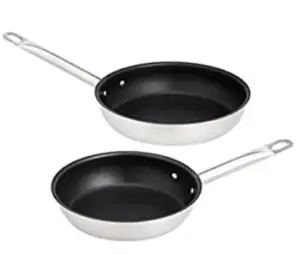
How do I know if my pan is dishwasher safe?
Dishwasher safe symbol
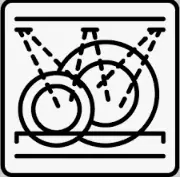
The 18/10 quality stainless steel is generally indicated by the manufacturer on the product packaging. In addition, the symbol indicating that it is dishwasher safe will be displayed either on the packaging or directly on the back of the pan.
If the symbol is not displayed, this means that your stainless steel saucepan is not suitable for washing in the dishwasher. In this case, hand washing is more appropriate as well as immediate drying to avoid oxidation.
Is the machine wash result better than hand washing?
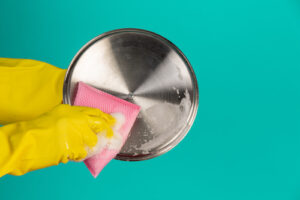
Even though the pan has the dishwasher safe symbol, it is of course best to opt for hand washing as often as you can.
Dishwasher detergents contain many active substances.
The main ones include: sequestrants, which fix the hardness of the water and thus prevent scale deposits, alkalinity which is necessary to soften dried-up dirt, enzymes that are excellent at reducing starch and dissolving proteins, and bleaching agents which are oxygen-based to remove color stains.
For regular cleaning, warm soapy water is sufficient. We invite you to read our article on the maintenance of stainless steel cookware.
It often happens after machine washing that your pan contains remnants of white or rainbow marks. These traces can easily be removed, however, for an optimal result, washing by hand remains the most effective.
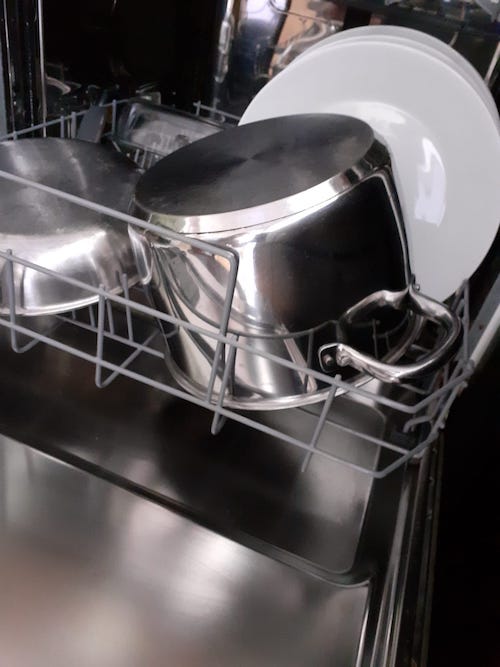
How to wash stainless steel pans in the dishwasher?
The best use of stainless steel in the dishwasher is summarized in 5 simple steps to ensure the best result.
In 5 minutes, you will have adapted the right gestures to fill and start your dishwasher!
Total Time: 5 minutes
Dispose of leftover

Dispose of leftover food with a nylon brush before putting your pans in the appliance.
Pre-washing with running water is essential. This way you avoid clogging the filter of your dishwasher and improve the washing quality.
Arrange the dishes correctly

Arrange the dishes correctly so that they are completely doused with water, otherwise, they will not be properly clean! Avoid placing utensils on top of each other or covering them to facilitate basting on all utensil surfaces.
Place hollow containers such as saucepans, pots, and salad bowls in the baskets with their opening facing downwards.
With some dishwasher manufacturers, you have the option of being able to fold down the rows of spikes in order to have more space for large items of crockery such as pots and pans.
Make sure that items that are too high or protrude from the baskets do not block the spray arms. If necessary, check by rotating the arms by hand.
Position the detergent
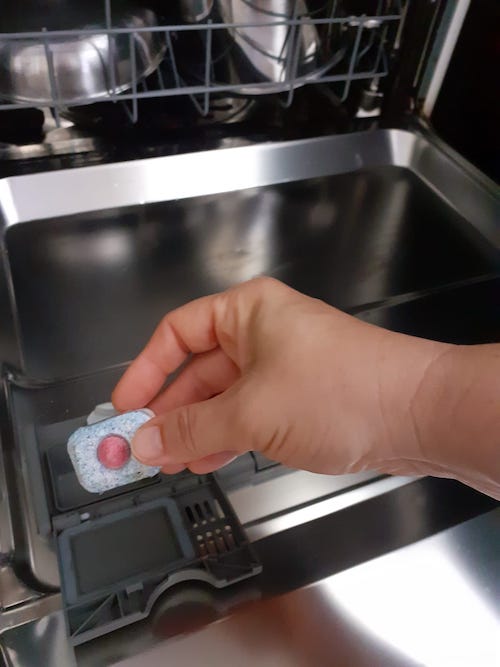
Use only detergents intended for household dishwashers and respect the doses indicated.
Detergent tablets contain an amount of cleaner that is sufficient in most cases.
Besides normal detergents, there are products combining different functions “all in 1” or “3 in 1” including regeneration salt and rinsing products.
As with the special “glass protection” tablets, there are special “stainless steel shards” tablets. You will obtain the best washing and drying results by using normal detergents and dosing regeneration salt and rinse aids separately.
Choose a wash program
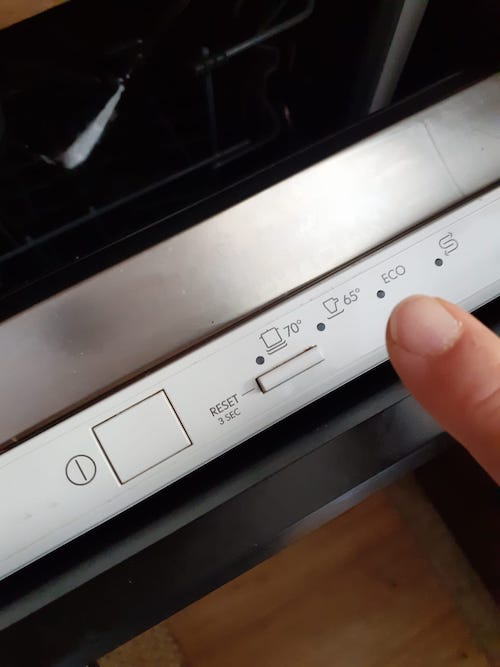
Choose a wash program that is more or less intensive depending on how dirty your dishes are.
Drying your dishes
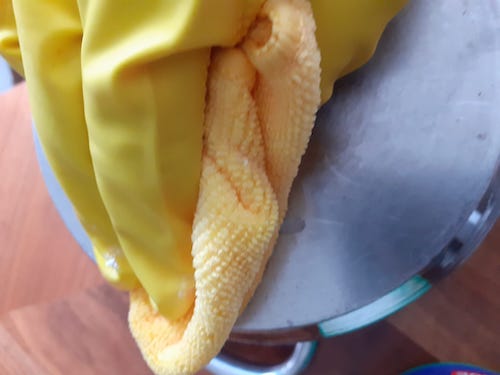
Drying your dishes with a towel or microfiber cloth once the cycle has been completed is essential to avoid water traces or spots and the impression of leftover dirt.
After washing, residues of white traces due to the washing salt or rainbow traces may remain due to food starch residue.
In this case, apply white vinegar with a microfiber cloth or follow our maintenance recommendations for stainless steel kitchenware.
Your Casseroles do not wash well in the dishwasher?
- Check beforehand if the program of your dishwasher corresponds well to the cleaning of your pans. If the dirt is stubborn, choose a suitable program.
- Clean your filter regularly after each wash. Remove the combined filter and the coarsest impurities and rinse it well under running water. You can also use a dish brush, if necessary. The
- spray arm nozzles may also be clogged so ensure that you check them as well.
- Is there enough salt and rinse aid left?
- The pans may not have been arranged correctly to facilitate the flow of water.
The detergent you are using may not be effective enough so it’s best to change the brand of detergent.
Adopt an ecological way of washing when cleaning your stainless steel pans

If you prefer to rinse your dishes before placing them in the dishwasher tray, rinse them in a small volume of water the size of a basin rather than running the dishwasher. The reason for this is to avoid running the water for too long which may cause wastage.
Make use of the full capacity of the racks without overloading your dishwasher.
This is how your dishes will be done as economically as possible.Choose a program that matches the type of dishes and the degree of soiling.
![]() To wash while saving energy, select the ECO program. The “Economic” wash allows a reduction in energy consumption of up to 20%. To ensure that the dishwasher can guarantee an optimal washing result, the program duration is therefore increased.
To wash while saving energy, select the ECO program. The “Economic” wash allows a reduction in energy consumption of up to 20%. To ensure that the dishwasher can guarantee an optimal washing result, the program duration is therefore increased.
Opt for ecological detergent tablets to avoid polluting the water with chemical substances that harm the environment.
FAQ- Frequently Asked Questions
What will happen if I wash non-compliant stainless steel in the dishwasher ?
In this case, the stainless steel will rust on contact with humidity and heat. It is therefore not suitable for the dishwasher.
How do I know if my pan is stainless steel or aluminum?
A quick and easy way to find out if your pan is stainless steel or aluminum is to take a magnet and place it on the surface of the pan. If it catches with the magnetic power it’s stainless steel and if it doesn’t catch, then you know it’s aluminum.
Is induction stainless steel dishwasher safe?
Induction stainless steel has a superior quality coating that is dishwasher safe.
